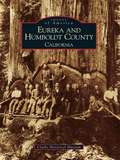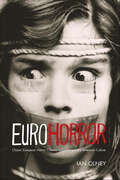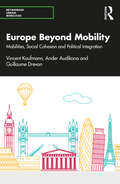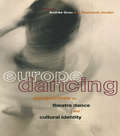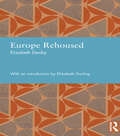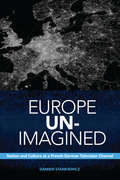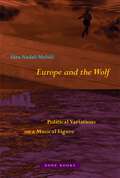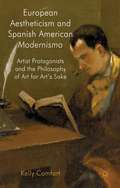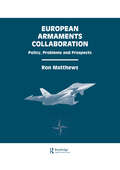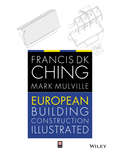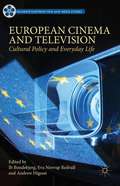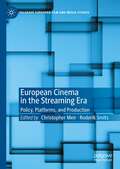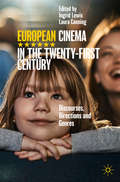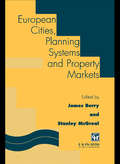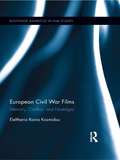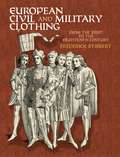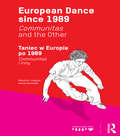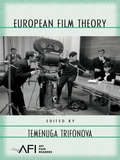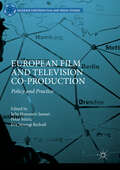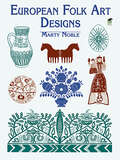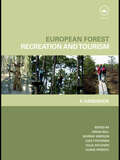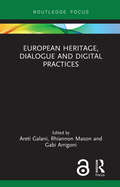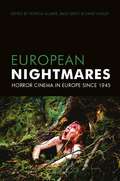- Table View
- List View
Eureka and Humboldt County: California
by Clarke Historical MuseumThe cry amongst the redwoods-Eureka!-was the shout heard from early pioneers in 1850 as they came to settle in Humboldt County. Discovery of gold permanently changed the area's history, and eventually lead to the extraction of Humboldt's other natural resource: the "red gold" of its forests. Captured here in over 200 vintage photographs is the pictorial history of this bountiful county and its residents.As the gold fever faded in the late 1800s, Humboldt County's primary source of industry became the lumbering of its vast redwoods. Pictured here are the men and machines that felled, transported, and milled the lumber, as well as photographs of the elegant Victorian mansions of the industry's lumber barons, such as William Carson. Weaving the history of Humboldt County together are the stories of its earliest residents, including the Native American tribes, fevered Gold Rushers, the early Chinese community, railroad workers, shipyard sailors, and industrious farming families, all of whom created the foundation it prospers on today.
Euro Horror: Classic European Horror Cinema in Contemporary American Culture (New Directions in National Cinemas)
by Ian OlneyBeginning in the 1950s, "Euro Horror" movies materialized in astonishing numbers from Italy, Spain, and France and popped up in the US at rural drive-ins and urban grindhouse theaters such as those that once dotted New York's Times Square. Gorier, sexier, and stranger than most American horror films of the time, they were embraced by hardcore fans and denounced by critics as the worst kind of cinematic trash. In this volume, Olney explores some of the most popular genres of Euro Horror cinema—including giallo films, named for the yellow covers of Italian pulp fiction, the S&M horror film, and cannibal and zombie films—and develops a theory that explains their renewed appeal to audiences today.
Europe Beyond Mobility: Mobilities, Social Cohesion and Political Integration (Networked Urban Mobilities Series)
by Vincent Kaufmann Ander Audikana Guillaume DrevonMobility, which has represented a critical scientific category and political driver, is currently under strong public scrutiny: has mobility lost its potential for social cohesion and political integration? Europe Beyond Mobility: Mobilities, Social Cohesion and Political Integration assesses this question by focusing on the European integration process, conceptualized as a political project for the promotion of different flows of mobility. Mobility has been a fundamental tool for territorial strength and political integration among European countries. Based on a realistic understanding of the potentials and limits of mobility, this book pleads for a "resonant mobility" in the interest of a renovated European integration process. It examines how, in opposition to those advocating for national borders and mobility restrictions, the EU needs to explore new regulatory models which limit mobility’s adverse social, economic, and environmental impacts and make accessible the benefits of alternative flow models. It also provides an analytical framework for the study of current trends of mobility limitation, migration restriction and re-bordering, and offers a complementary and innovative framework for the study of globalization. Europe Beyond Mobility will be of interest to academics and students as well as policy makers and practitioners internationally in the fields of mobility, migration and border studies.
Europe Dancing: Perspectives on Theatre, Dance, and Cultural Identity
by Andree Grau Stephanie JordanEurope Dancing examines the dance cultures and movements which have developed in Europe since the Second World War. Nine countries are represented in this unique collaboration between European dance scholars. The contributors chart the art form, and discuss the outside influences which have shaped it. This comprehensive book explores: * questions of identity within individual countries, within Europe, and in relation to the USA * the East/West cultural division * the development of state subsidy for dance * the rise of contemporary dance as an 'alternative' genre * the implications for dance of political, economic and social change. Useful historical charts are included to trace significant dance and political events throughout the twentieth century in each country. Never before has this information been gathered together in one place. This book is essential reading for everyone interested in dance and its growth and development in recent years.
Europe Rehoused (Studies in International Planning History)
by Elizabeth DenbyEurope Rehoused was one of the most influential housing texts of the 1930s, and is still widely cited. Written by the housing consultant Elizabeth Denby (1894-1965) it offered a survey of the nearly two decades of social housing built across Europe since the end of World War One, with the aim of informing British policy makers; as a reviewer declared ‘it has a decidedly propagandist flavour’. Denby was a leading figure in housing debates in the 1930s. Adopting a line in sharp critique of what she saw as the entirely materialist approach of state housing policy, Denby advocated the incorporation of social amenities alongside well-designed and equipped flats and houses, ideally sited within urban areas; by the late 1930s she was a pioneering advocate of the concept of mixed development. Europe Rehoused is divided into two parts. The first considered the origins of the housing problem of the inter-war decades, which Denby dated to the onset of the Industrial Revolution. She then examined the various national factors which influenced the problem: climate, post-war economy and the nature of land ownership. Finally she discussed the financial aspect: the bodies responsible for house building and the nature of the subsidies available for building. This was very much a schematic survey and the second, and largest, part of the book was devoted to individual studies of European practice, and discussed ‘two winners in the War, two losers and two neutrals’: Sweden, Holland, Germany, Vienna, Italy and France. This section was completed with a concluding chapter in which she compared continental work with the British system, and the lessons that could be learnt in this country from abroad. Although Denby’s book was not the only one of its sort, its importance lies in its polemical nature and its advocacy of a rehousing policy which would become widely adopted after WWII. Significant too, is that the book is the voice of a woman who had assumed a significant status as a housing expert in the inter-war decades; Walter Gropius, who wrote the introduction to the US edition of the book observed that the book ‘carried the weight of perfect expertness.’ Such voices have for too long been overlooked, yet Denby was formed part of a very strong tradition of women reformers who worked to re-shape the inter-war and post-war British built environment.
Europe Un-Imagined: Nation and Culture at a French-German Television Channel
by Damien StankiewiczEurope Un-Imagined examines one of the world’s first and only trans nationally produced television channels, Association relative à la télévision européenne (ARTE). ARTE calls itself the "European culture channel" and was launched in 1991 with a French-German intergovernmental mandate to produce television and other media that promoted pan-European community and culture. Damien Stankiewicz’s ground-breaking ethnographic study of the various contexts of media production work at ARTE (the newsroom, the editing studio, the screening room), reveals how ideas about French, German, and European culture coalesce and circulate at the channel. He argues that the reproduction of nationalism often goes unacknowledged and unremarked upon, and questions whether something like a European "imagination" can be produced. Stankiewicz describes the challenges that ARTE staff face, including rapidly changing media technologies and audiences, unreflective national stereotyping, and unwieldy bureaucratic infrastructure, which ultimately limit the channel’s abilities to cultivate a transnational, "European" public. Europe Un-Imagined challenges its readers to find new ways of thinking about how people belong in the world beyond the problematic logics of national categorization.
Europe and the Wolf: Political Variations on a Musical Figure
by Sara Nadal-MelsióHow the work of several contemporary artists illuminates and challenges the policing of European borders and identityIn this stunningly original book, Sara Nadal-Melsió explores how the work of several contemporary artists illuminates the current crisis of European universalist values amid the brutal realities of exclusion and policing of borders. The &“wolf&” is the name Baroque musicians gave to the dissonant sound produced in any attempt to temper and harmonize an instrument. Europe and the Wolf brings this musical figure to bear on contemporary aesthetic practices that respond to Europe&’s ongoing social and political contradictions. Throughout, Nadal-Melsió understands Europe as a conceptual problem that often relies on harmonization as an organizing category. The &“wolf&” as an emblem of disharmony, incarnated in the stranger, the immigrant, or the refugee, originates in the Latin proverb &“man is a wolf to man.&” This longstanding phrase evokes the pervasive fear, and even hatred, of what is foreign, unknown, or beyond the borders of a community. The book follows the &“wolf&” in a series of relays between the musical, the visual, and the political, and through innovative readings of artworks—by, among others, Carles Santos, Pere Portabella, Allora&Calzadilla, and Anri Sala. Traversed by the musical, these artworks, as well as Nadal-Melsió&’s writing, present unstable symbolic and material ensembles in an array of variations of political possibilities and impossibilities that evade institutions intolerant of uncertainty and wary of diversity.
European Aestheticism and Spanish American Modernismo
by Kelly ComfortEuropean Aestheticism and Spanish American Modernismo examines the changing role of art and the artist during the turn-of-the-century period and considers the multiple dichotomies of art and life, aesthetics and economics, production and consumption, and center and periphery. Through a comparative analysis of fictional works from Wilde, Huysmans, and Mann in the European context and Dario, Silva, Casal, and Gutierrez Najera in the Spanish American context, this transatlantic study locates a shared interest in the philosophy of 'art for art's sake' in both aestheticism and modernismo. The analysis of the aims and attitudes of different types of artist protagonists considers the intersection between the artist figure and the impressionistic and creative critic (chapters 1 and 2), the producers and consumers of art (chapters 3 and 4), and the aesthete, the dandy, and the flaneur (chapters 5 and 6). It also outlines the ways in which the artist figures avoid 'art for life's sake' (Part I), protest 'art for the market's sake' (Part II), or promote 'life for art's sake' (Part III). "
European Armaments Collaboration: European Armaments Collaboration: Policy Problems And Prospects (Routledge Studies in Defence and Peace Economics #1)
by Ron MatthewsFirst published in 1992. The changing strategic environment of the 1990s has been characterised by events such as the Middle-East conflagration and super-power disarmament which represent the two opposing ends of the present security spectrum. The framing of appropriate defence policies now depends on increased NATO industrial defence restructuring and cooperation, especially within Europe. This book identifies, explains and analyses the key issues involved in Europe's defence-industrial reorganisation progress. It tackles head-on controversial issues such as: divergences between practice and policy in NATO US-European positions; the high costs of collaborative ventures; competition vs concentration and the complexities of adopting an European defence consensus within NATO. At a time when the diminution of NATO's defence-industrial base goes hand-in-hand with product reorientation and specialization, this book provides concise, critical and contemporary assessment of European and NA TO collaborative issues.
European Building Construction Illustrated
by Francis Dk Ching Mark MulvilleThe first European edition of Francis DK Ching's classic visual guide to the basics of building construction. For nearly four decades, the US publication Building Construction Illustrated has offered an outstanding introduction to the principles of building construction. This new European edition focuses on the construction methods most commonly used in Europe, referring to European building regulations and standards, while applying Francis DK Ching's clear graphic signature style. It provides a coherent and essential primer, presenting all of the basic concepts underlying building construction and equipping readers with useful guidelines for approaching any new materials or techniques they may encounter. European Building Construction Illustrated provides a comprehensive and lucid presentation of everything from foundations and floor systems to finish work. Laying out the material and structural choices available, it provides a full understanding of how these choices affect a building′s form and dimensions. Complete with more than 1000 illustrations, the book moves through each of the key stages of the design process, from site selection to building components, mechanical systems and finishes. Illustrated throughout with clear and accurate drawings that effectively communicate construction processes and materials Provides an overview of the mainstream construction methods used in Europe References relevant building regulations and standards and the leading environmental assessment methods of BREEAM and LEED, while outlining the Passive House Standard Includes emerging construction methods driven by the sustainability agenda, such as structural insulated panels and insulating concrete formwork Features a chapter dedicated to construction in the Middle East, focusing on the Gulf States
European Cinema and Television
by Andrew Higson Eva Novrup Redvall Ib BondebjergThis book offers comparative studies of the production, content, distribution and reception of film and television drama in Europe. The collection brings together scholars from the humanities and social sciences to focus on how new developments are shaped by national and European policies and practices, and on the role of film and television in our everyday lives. The chapters explore main trends in transnational European film and television fiction, addressing issues of co-production and collaboration, and of how cultural products circulate across national borders. The chapters investigate how watching film and television from neighbouring countries can be regarded as a special kind of cultural encounter with the possibility of facilitating reflections on national differences within Europe and negotiations of what characterises a national or a European identity respectively.
European Cinema in the Streaming Era: Policy, Platforms, and Production (Palgrave European Film and Media Studies)
by Christopher Meir Roderik SmitsThis collection examines the impact of streaming platforms on European cinema. It is structured from three distinct points-of-view: the policy issues related to streaming platforms, equally at the European level and in individual countries; the impact of platforms on the circulation of European films, including some of the global players, multi-national and single-nation platforms operating in Europe; and the production activities of the platforms in the form of specific ‘original’ films. By bringing together scholars working on various national cinemas, including those of France, Spain, Britain and other countries, this collection illuminates the many ways in which the European film industry is responding to the digital revolution.Chapter 5 is available open access under a Creative Commons Attribution 4.0 International License via link.springer.com.
European Cinema in the Twenty-First Century: Discourses, Directions and Genres
by Ingrid Lewis Laura CanningThis book rethinks the study of European Cinema in a way that centres on students and their needs, in a comprehensive volume introducing undergraduates to the main discourses, directions and genres of twenty-first-century European film. Importantly, this collection is the first of its kind to apply a transversal approach to European Cinema, bringing together the East and the West, while providing a broad picture of key trends, aesthetics, genres, national identities, and transnational concerns. Lewis and Canning’s collection effectively addresses some of the most pressing questions in contemporary European film, such as ecology, migration, industry, identity, disability, memory, auteurship, genre, small cinemas, and the national and international frameworks which underpin them. Combining accessible original research with a thorough grounding in recent histories and contexts, each chapter includes key definitions, reflective group questions, and a summative case study. Overall, this book makes a strong contribution to our understanding of recent European Cinema, making it an invaluable resource for lecturers and students across a variety of film-centred modules.
European Cities, Planning Systems and Property Markets
by James Berry Stanley McGrealA common theme running through both the market economies of Western Europe and the old command economies of Eastern Europe is the desire to combine local economic development objectives with those of the international investor. It is in this context that the interaction between planning systems and property markets is of paramount importance.
European Civil War Films: Memory, Conflict, and Nostalgia (Routledge Advances in Film Studies)
by Eleftheria Rania KosmidouThis book examines the ways in which late twentieth-century European cinema deals with the neglected subject of civil war. Exploring a range of films about the Spanish, Irish, former Yugoslavia, and Greek civil wars, this comparative and interdisciplinary study engages with contemporary debates in cultural memory and investigates the ways in which cinematic postmemory is problematic. Many of the films present an idealized past that glosses over the reality of these civil wars, at times producing a nostalgic discourse of loss and longing. Other films engage with the past in a melancholic fashion. These cinematic discourses articulate contemporary concerns, especially the loss of ideology and a utopian political horizon in the aftermath of the collapse of the Soviet bloc in 1989, a date that marks a significant break in European history and an accompanying paradigm shift in European cultural memory. Filmmakers examined include Trueba, Cuerda, Loach, Jordan, Kusturica, Dragojević, and Angelopoulos.
European Civil and Military Clothing: From The First To The Eighteenth Century (Dover Fashion and Costumes)
by Sir Frederic StibbertA wealthy Anglo-Italian connoisseur devoted to the nineteenth-century struggle for Italian unification, Frederick Stibbert amassed an extensive collection of arms, armor, and costume -- which today can be found in the Tuscan museum bearing his name. During the years in which he built up the museum's collection, he examined countless illuminated manuscripts, ancient documents, frescoes, paintings, and other records of armor and dress.The illustrations in this book, based on exceptional drawings by Stibbert himself and engraved by leading craftsmen of the day, reveal a remarkable panorama of European costume history. The volume contains 217 handsome plates depicting nearly 1,000 individual figures and their accessories, all scrupulously accurate and rendered in meticulous detail. Here are excellent illustrations of priests, warriors, Roman citizens, and women of ancient Britain; the German Emperor Otto and his wife; French monarchs and Scottish kings; jousting English knights of the thirteenth century; fifteenth-century Italian gentlewomen; elaborately coiffed ladies from the court of Versailles; and much more. Captions give the origins of the armor and dress, the sources of the drawings, precise descriptions of each item represented, and explanations of the function and manner of wearing armor.This extraordinary work has wide appeal: fashion historians will be attracted by its scrupulous accuracy and the authenticity of the garments; the royalty-free illustrations will be prized by artists and illustrators; and the handsome engravings and informative captions will entertain and instruct readers interested in the history of costume.
European Dance since 1989: Communitas and the Other
by Joanna SzymajdaThis edited collection charts the development of contemporary dance in Central and Eastern Europe since the literal and symbolic revolutions of 1989. Central Europe and the former Soviet Bloc countries were a major presence in dance – particularly theatrical dance – throughout the twentieth century. With the fragmentation of traditional structures in the final decade of the century came a range of aesthetic and ideological responses from dance practitioners. These ranged from attempts to reform classical ballet to struggles for autonomy from the state, and the nature of each was influenced by a set of contexts and circumstances particular to each country. Each contribution covers the strategies of a different country’s dance practitioners, using a similar structure in order to invite comparisons. In general, they address: Historical context, showing the roots of contemporary dance forms The socio-political climates that influenced emerging companies and forms The relationships between aesthetic exploration and institutional patronage The practitioners who were central to the development of dance in each country A diagnosis of the current state of the art and how it has come about The book’s main through-line is the concept of community, and how all of the different approaches that it documents have in some way engaged with this notion, consciously or otherwise. This can take the form of oppositional relationships, institutional formations, or literally, in identifiable communities of dancers and choreographers.
European Film Theory (AFI Film Readers)
by Temenuga TrifonovaEuropean Film Theory explores the ‘Europeanness’ of European film theory, its philosophical origins, the ‘culture wars’ between ‘Continental’ and ‘Analytical’ film theory and philosophy, the major discursive and epistemological shifts in the history of Continental film theory, the relationship between Continental philosophy of art and philosophy of history and European film theory. Writing from a range of disciplines and perspectives, the contributors to this new volume in the AFI FILM READERS series offer fresh interpretations of European film theorists and illuminate the political potential of European film theory.
European Film and Television Co-production: Policy and Practice (Palgrave European Film and Media Studies)
by Eva Novrup Redvall Julia Hammett-Jamart Petar MitricThis volume offers an up-to-date analysis of film and television co-production in Europe. It brings together the voices of policy professionals, industry practitioners and media industry scholars to trace the contours of a complex practice that is of increasing significance in the global media landscape. Analysis of the latest production statistics sits alongside interviews with producers and the critical evaluation of public film policies. The volume incorporates contributions from representatives of major public institutions—Eurimages, the European Audiovisual Observatory and the European Commission—and private production companies including the pan-European Zentropa Group. Policy issues are elucidated through case studies including the Oscar-winning feature film Ida, the BAFTA-winning I am not a Witch and the Danish television serial Ride Upon the Storm. Scholarly articles span co-development, co-distribution and regional cinemas as well as emerging policy challenges such as the digital single market. The combination of qualitative and quantitative approaches, and the juxtaposition of industry and scholarly voices, provides a unique perspective on European co-production that is information-rich, complex and stimulating, making this volume a valuable companion for students, scholars, and industry professionals.
European Folk Art Designs (Dover Pictorial Archive)
by Marty NobleThis handsome collection contains scores of unique images based on folk art designs created by artists of Austria, Poland, Hungary, Russia, Switzerland, and other European countries.Adapted from authentic sources, 265 original renderings depict scores of charming motifs incorporating florals, wildlife, riders on horseback, mythical figures, men and women in traditional costumes, and religious and secular motifs. Ideal for adding a touch of Old World flavor to a variety of projects, these eye-catching, stylized designs appear in assorted configurations, among them borders, squares, circles, medallions, and rectangles.Painstakingly reproduced and attractively presented, the designs represent a valuable resource of inspirational and practical art. The collection will be a major addition to the bookshelves of artists, designer, and craftworkers.
European Forest Recreation and Tourism: A Handbook
by Simon Bell Ulrike Pröbstl Murray Simpson Liisa Tyrväinen Tuija SievänenIn an increasingly urbanized world more and more people are turning to our forests and woodland for recreation and tourism. Planning and providing for this growing demand poses challenges that need to be addressed by managers and designers alike. Based on a study of forest recreation from across Europe, the editors bring together the expertise of more than eighty leading professionals and academics to provide a clear and concise guide to best practice. Case studies and careful research give a detailed insight into the issues that forest recreation raises, from strategic planning to integration into the existing rural economy. Essential reading for tourism planners, landscape designers and countryside managers delivering forest recreation and tourism.
European Heritage, Dialogue and Digital Practices (Critical Heritages of Europe)
by Rhiannon Mason Areti Galani Gabi ArrigoniEuropean Heritage, Dialogue and Digital Practices focuses on the intersection of heritage, dialogue and digital culture in the context of Europe. Responding to the increased emphasis on the potential for heritage and digital technologies to foster dialogue and engender communitarian identities in Europe, the book explores what kind of role digital tools, platforms and practices play in supporting and challenging dialogue about heritage in the region.Drawing on fieldwork involving several European museums and heritage organisations, the chapters in this volume critically engage with the role of digital technology in heritage work and its association with ideas of democratisation, multivocality and possibilities for feedback and dialogic engagement in the emerging digital public sphere. The book also provides a framework for understanding dialogue in relation to other commonly used approaches in heritage institutions, such as participation, engagement and intercultural exchange. The authors map out the complex landscape of digitally mediated heritage practices in Europe, both official and unofficial, by capturing three distinct areas of practice: perceptions and applications of digitally mediated dialogues around heritage within European museums and cultural policy, facilitation of dialogue between European museums and communities through participatory design approaches and non-official mobilisation of heritage on social media. European Heritage, Dialogue and Digital Practices will be of interest to both scholars and students in the fields of heritage and museum studies, digital heritage, media studies and communication, the digital humanities, sociology and memory studies. The book will also appeal to policy makers and professionals working in a variety of different fields.
European Landscape Architecture: Best Practice in Detailing
by Ian H. Thompson Torben Dam Jens Balsby NielsonDrawing together case studies from all over Europe, this text explores the relationship between the overall idea of the landscape architecture for a site and the design of details. Examining concept sketches and design development drawings in relation to the details of the design, the book offers a more profound understanding of decision making through all stages of the design process. The book includes the study of the choice of materials and techniques of construction, and explores the cultural and symbolic significance of such choices, as well as questions of environmental sustainability. With projects analyzed and evaluated here that have won international acclaim, or have been awarded national prizes, European Landscape Architecture is a core book in the study and understanding of the subject.
European Nightmares: Horror Cinema in Europe Since 1945
by Patricia David Brick Eds. Emily Allmer HuxleyThis volume is the first edited collection of essays focusing on European horror cinema from 1945 to the present. It features new contributions by distinguished international scholars exploring British, French, Spanish, Italian, German and Northern European and Eastern European horror cinema. The essays employ a variety of current critical methods of analysis, ranging from psychoanalysis and Deleuzean film theory to reception theory and historical analysis. The complete volume offers a major resource on post-war European horror cinema, with in-depth studies of such classic films as Seytan (Turkey, 1974), Suspiria (Italy, 1977), Switchblade Romance (France, 2003), and Taxidermia (Hungary, 2006).
European Nightmares: Horror Cinema in Europe Since 1945
by Patricia Allmer David Huxley Emily BrickThe first edited collection of essays focusing on European horror cinema from 1945 to the present.
